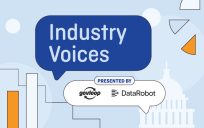 Artificial intelligence (AI) is no longer theoretical. It’s growing in use everywhere from determining the best spot on the court to shoot a three-pointer to assisting doctors with finding a cure for cancer. Judging by advertisements and creative campaigns (AI can make you a taco!), everyone is using it. Despite this prevalence of AI marketing, the truth is quite different. A lot of AI marketing is just buzz. A recent UK study showed that more than 40% of startups classified as AI had no actual AI in their solutions or operations.[1]
Artificial intelligence (AI) is no longer theoretical. It’s growing in use everywhere from determining the best spot on the court to shoot a three-pointer to assisting doctors with finding a cure for cancer. Judging by advertisements and creative campaigns (AI can make you a taco!), everyone is using it. Despite this prevalence of AI marketing, the truth is quite different. A lot of AI marketing is just buzz. A recent UK study showed that more than 40% of startups classified as AI had no actual AI in their solutions or operations.[1]
We are at the beginning of the AI revolution. There’s no doubt that the future will be augmented by AI, and organizations and society will benefit. Many organizations are just starting to explore how and where to integrate it to ensure success and minimize risk. Implementation is happening slowly — as it should. While AI offers promise, it’s not an endeavor to undertake without preparation.
The Bad and the Good of AI Implementation
If you’re embarking on this journey, here’s what you need to know. Keep in mind there are very real downsides and upsides to AI today and tomorrow.
The Bad
- While AI is machine-driven, it remains highly susceptible to bias ranging from demographic categories like gender and race, to more innocuous heuristic-based decision-making frameworks.[2] It’s important that government agencies remain vigilant against bias in using AI for predictive intelligence.
- Government organizations have substantial amounts of data that can’t be applied to training AI systems. Data sets are often incomplete or lack critical attributes, so a team must clean and complete raw data before it’s useful.
- Many government agencies are operating on legacy IT infrastructures built for individual tasks rather than big data, which presents a barrier to adoption as systems can’t access required data.
- FOMO is real. Leaders who hear the buzz about AI and want to be part of the ‘cool’ crowd may rush implementation, which can mean applying AI without the necessary data or processes. It also can mean setting unrealistic expectations.
- AI can be hacked. If organizations don’t understand how AI works, they certainly won’t be able to spot what hacked AI looks or operates like.
Despite these risks and fears, like the concerns about AI replacing human jobs, in reality, AI has its very real upsides, particularly as it works in collaboration with humans.[3]
The Good
Starting AI implementation can be simple and gradual. It does not need to require a full IT transformation or agency overhaul. Once in place, AI can provide immediate value in several ways:
- Customer service chatbots can create connections with customers that humans can’t sustain.[4]
- Processing and handling times go down when AI is used to shift employees to higher value tasks.[5]
- Fraud reduction and risk alerts become more consistent and reliable, saving money – as when the state of New York leveraged an AI system to stop tax return fraud, increasing returns from $10MM-$20MM to nearly $40MM annually.
- AI can augment decision-making, whether by identifying previously unseen insights from data, developing new data sets for analysts, or augmenting teams to increase efficiencies across key processes.
The key is the combination of the AI and the human, and not relying on AI to replace humans.
Quick Steps to Get Started
Think of AI implementation like a recipe. Begin by understanding what you want the meal to be, put the ingredients and cooking tools in place, and have a sense of what ‘good’ looks like. In AI terms, it translates to a step-by-step plan:
- Understand your IT infrastructure (including upgrades!)
- Identify what data you have, and the most data-heavy aspects of your organization
- Assess the current state of documented processes and operational governance
- Prioritize tasks based on repetition, complexity, and value
- Engage your stakeholders in the design and planning to increase adoption and trust
- Develop a governance mechanism for AI systems (remembering bias and adversarial issues)
- Communicate plans to the stakeholders, explaining impacts and implications
As you consider what intelligent growth looks like, look at how you can leverage the incredible potential of AI. It may be as simple as an editing tool or as complex as advanced security measures. Regardless, begin with the objective in mind and enlist the support of knowledgeable partners.
Tyler Sweatt is a GovLoop Featured Contributor. He is the founder and Managing Partner at Future Tense. Tyler works to identify and address risks and opportunities in changing environments. He advises startups across the cybersecurity, artificial intelligence, and physical security domains, and regularly supports R&D, S&T, M&A and strategy initiatives across DHS, DoD, the IC and Fortune 500 organizations. Previously, Tyler worked at futurist consulting firm Toffler Associates, leading emerging technology and security efforts, and worked at Deloitte where he focused on rapid technology acquisition for DoD. A West Point graduate, Tyler served as a Combat Engineer and Counterintelligence Officer with the Army, serving multiple combat deployments. You can find him on Twitter @Tyler_Sweatt.





Great post! You made a great argument for implementing and leveraging AI more strategically.